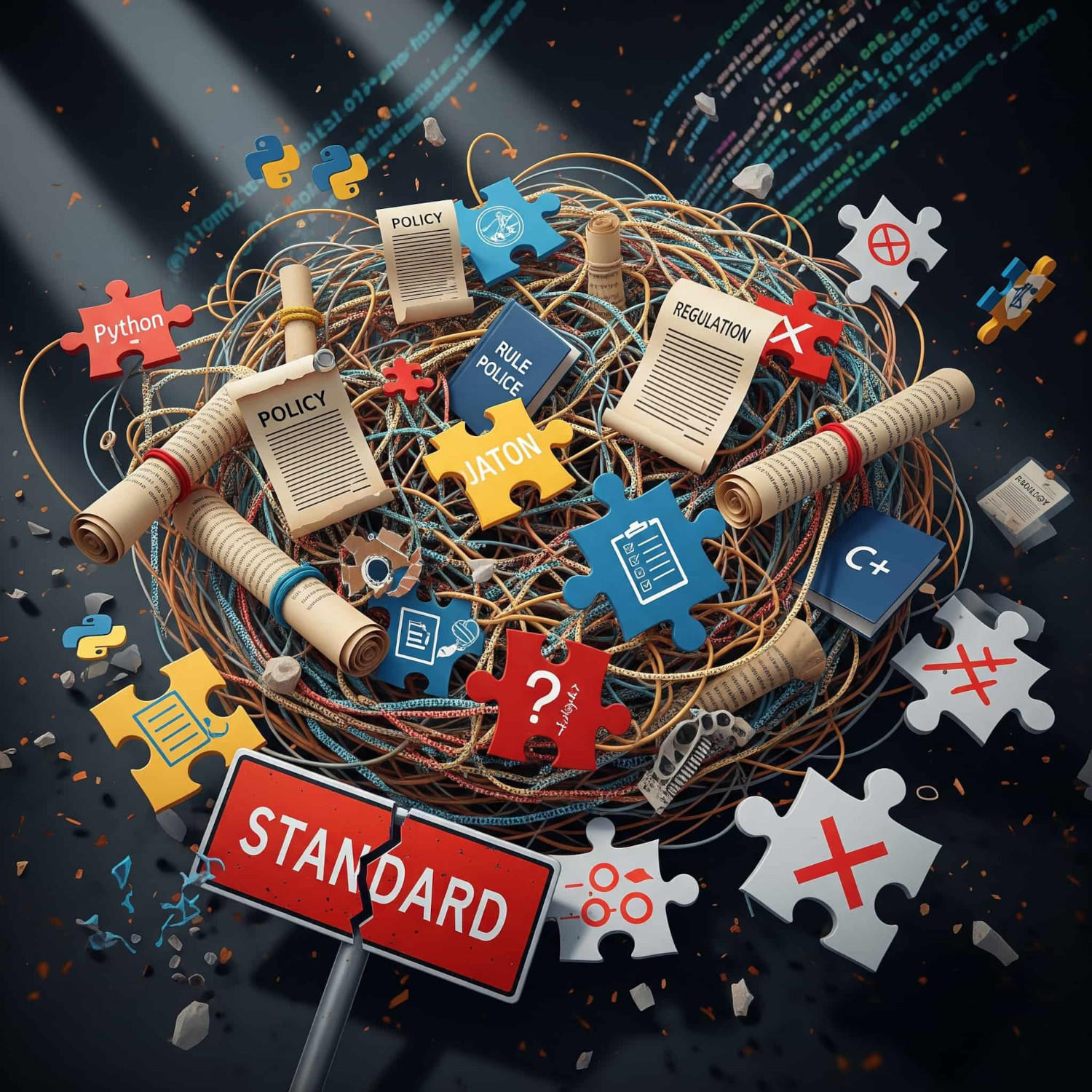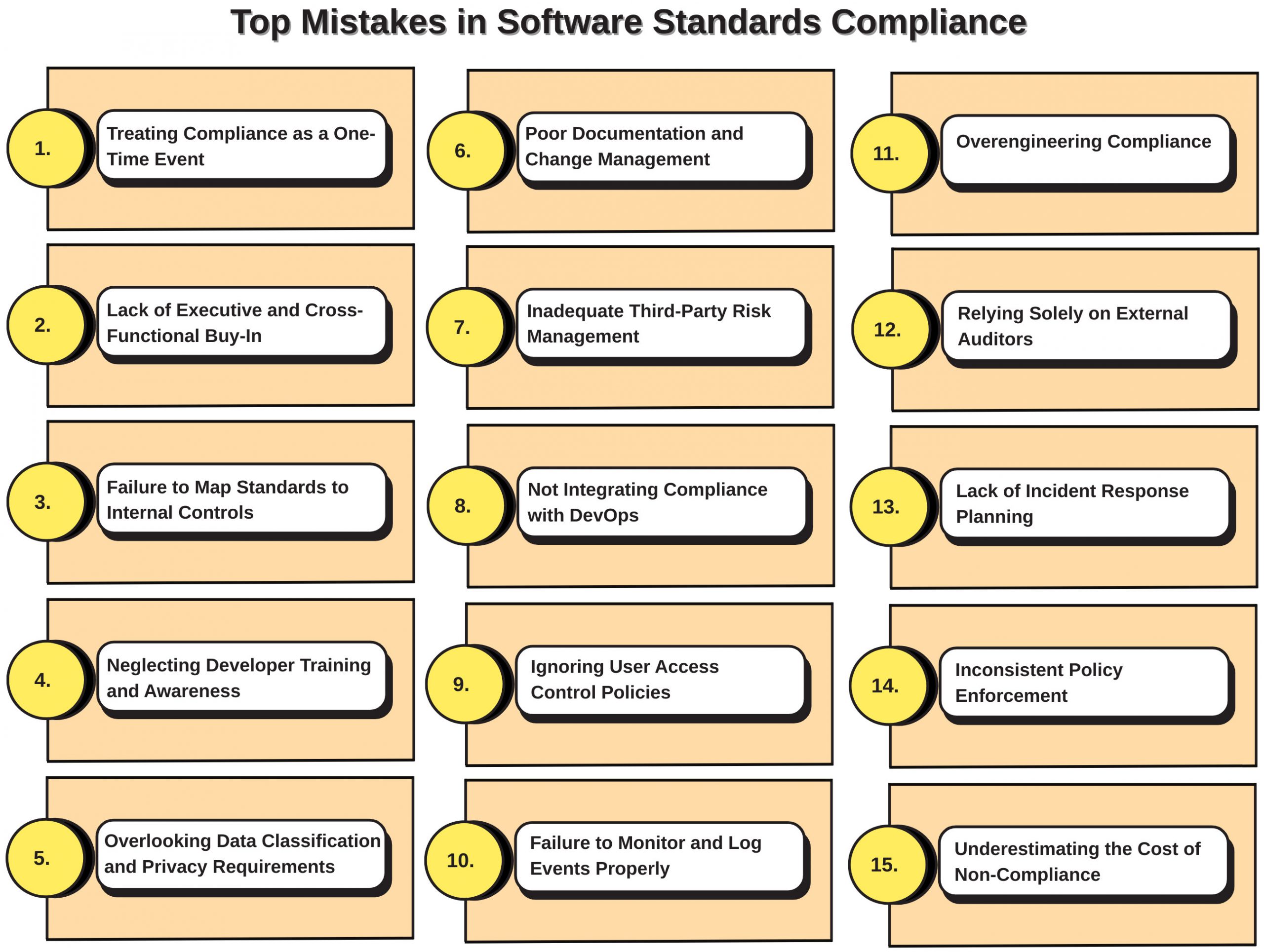Top Mistakes in Software Standards Compliance
|
|
Ever wondered why software compliance gets baked into your development even if the client hasn’t explicitly asked for it?
Well, developers are in the business of software quality, and software standards and compliance are the backbone of reliable, secure, and maintainable software systems. Hence, it becomes crucial to adhere to compliance standards so that your software is recognized for its quality, reliability, and security.
In this article, we will understand what software standards compliance is and list the top mistakes organizations make when attempting to achieve or maintain compliance.
| Key Takeaways: |
|---|
|

What is Software Standards Compliance?
Software compliance is the term used to explain how well an application obeys the rules in a standard. It is a process by which businesses ensure they follow standards, laws, regulations, and ethical practices related to their industry.
Software standards compliance deals with various aspects such as data protection, labor laws, financial reporting, and environmental regulations. Adherence to compliance is not just about avoiding legal backlash; it’s also about maintaining trust with stakeholders.
As for the relationship between software quality and software compliance, if your application is compliant with software standards, it is less likely to contain bugs, security weaknesses, and design flaws. Conversely, if the software is free of bugs, weaknesses, and flaws, it is more likely comply with a software standard.
The government and various industry groups have issued many software standards to make software safe and secure for users. Standards help protect consumers from all harm, including identity theft and personal damage. Compliance standards cover every part of software development and deployment, ranging from variable naming conventions to incident response protocols.
The following tables list some of the critical software compliance standards:
| Software Compliance Standards | Description |
|---|---|
| ISO 27001 |
|
| GDPR |
|
| HIPAA |
|
| PCI DSS |
|
| ISO 9001 |
|
| CMMI |
|
| OWASP |
|
| FISMA |
|
| SOC 2 |
|
| CCPA |
|
One point should be duly noted: compliance doesn’t ensure quality, as no software standard addresses every aspect of software quality. Similarly, quality doesn’t translate to compliance.
To achieve compliance, you might have to produce, for example, certain types of documentation or add security testing at additional points in the software development life cycle (SDLC).
Additional quality standards one might need to consider:
- How to Achieve FedRAMP Compliance?
- How to achieve DORA compliance?
- 21 CFR Part 11 Compliance
- AI Compliance for Software
Development’s Responsibilities For Compliance
Software is the foundation of modern business operations. Any vulnerabilities in this software can have widespread and long-lasting consequences. Hence, it is necessary to enforce software standards on software because the potential cost of violating the standards is very high.
Although every department should strive to comply with industry standards, only the development team can create code that meets software standards. Thus, the whole organization depends on the development team to demonstrate that they are developing compliant software.
It’s up to the other departments to help them adhere to software coding and testing standards and meet all the requirements for proving compliance.
The Common Software Compliance Issues
The top mistakes in software standards compliance are explained here:

1. Treating Compliance as a One-Time Event
This is one of the most common errors that organizations make. They view compliance as a milestone and not as a continuous process. Many teams focus on passing an audit or certification, then neglect the ongoing maintenance.
Why It’s a Mistake:
The compliance standards environment is dynamic, and it continually evolves. Organizational processes are constantly updated, and new vulnerabilities emerge. In such situations, a one-and-done approach increases risk and outdated controls.
How to Avoid:
- Organizations should adopt continuous compliance practices.
- Monitoring tools should be integrated to track policy violations in real time.
- Periodic internal audits and reviews should be scheduled.
2. Lack of Executive and Cross-Functional Buy-In
Compliance spans all departments, including legal, HR, and operations. So it should not be taken only as a technical issue. Many organizations treat it as the sole responsibility of security and QA teams.
Why It’s a Mistake:
There may not be an executive or leader to provide support and interdepartmental coordination, which makes compliance efforts underfunded, lonely, and reactive instead of strategic.
How to Avoid:
- Organizations should ensure there is an executive sponsorship for compliance programs.
- They should build a cross-functional team representing engineering, legal, HR, and business units.
- The business value of compliance, along with legal requirements, should be communicated clearly.
3. Failure to Map Standards to Internal Controls
In their haste to gain certification or pass the audit, organizations often implement standards without aligning them with internal policies and existing controls.
Why It’s a Mistake:
This leads to gaps in compliance, redundant work, and inefficiencies during audits. Some areas may be overcompensated, while some may be underdelivered.
How to Avoid:
- The gap analysis should be performed between existing controls and the chosen standard.
- Each control in the standard should be mapped to existing processes and technology.
- For this purpose, tools like the NIST CSF mappings or ISO/IEC control spreadsheets can be used to visualize coverage.
4. Neglecting Developer Training and Awareness
Development process with its insecure code, lack of documentation, and improper data handling is often the source of compliance issues. In addition, compliance training often excludes developers.
Why It’s a Mistake:
Compliance becomes an afterthought for developers as they lack training and awareness. This leads to costly rework or vulnerabilities.
How to Avoid:
- Role-specific training should be provided for developers on relevant compliance topics like secure coding for PCI-DSS or privacy by design for GDPR.
- Compliance should be included as part of Include compliance as part of software development lifecycle (SDLC) requirements.
- While conducting code reviews, compliance should be kept in mind.
5. Overlooking Data Classification and Privacy Requirements
Failure to classify data correctly is yet another mistake organizations make. It is essential to understand what data is held and how it is protected, with regulations like GDPR and HIPAA.
Why It’s a Mistake:
Without proper classification, sensitive data may be stored or processed inappropriately, leading to security breaches and penalties.
How to Avoid:
- Organizations should have a data classification policy with sensitivity and regulatory scope.
- Automated tools should be used to scan and label data repositories.
- Data retention and processing practices should be reviewed regularly for compliance.
6. Poor Documentation and Change Management
Compliance audit readiness heavily depends on documentation of policies, procedures, logs, and change records. Poor documentation derails even otherwise compliant systems.
Why It’s a Mistake:
Documentation is evidence of compliance; without it, auditors cannot verify practices. Hence, even if good practices exist, they can result in non-compliance due to a lack of documentation.
How to Avoid:
- A centralized documentation repository is a must in an organization.
- All documents should be version-controlled.
- Establish a change management process for logging decisions, code changes, and configuration updates with compliance tags.
7. Inadequate Third-Party Risk Management
Software development heavily relies on third-party components such as open-source libraries, SaaS platforms, and APIs. However, the team does not evaluate if these third parties meet adequate compliance standards.
Why It’s a Mistake:
Third-party tools may contain vulnerabilities or non-compliance that can permeate in your software under shared responsibility.
How to Avoid:
- Organizations should maintain a vendor risk assessment process.
- Vendors should provide compliance certifications (e.g., SOC 2, ISO 27001).
- Regularly monitor for known vulnerabilities using tools such as Snyk or WhiteSource.
8. Not Integrating Compliance with DevOps
DevOps helps with continuous software delivery, but too often, compliance lags as the checks only occur post-release.
Why It’s a Mistake:
These post-release compliance checks lead to bottlenecks that require expensive remediations.
How to Avoid:
- Compliance should be shifted “left” in the SDLC.
- Compliance checks should be integrated with CI/CD pipelines by automating them.
- Use compliance-as-code frameworks (e.g., Open Policy Agent, Terraform compliance modules).
9. Ignoring User Access Control Policies
Access control policies determine who has access to what and how that access is granted. They are a central theme in most standards. However, organizations neglect access control policies.
Why It’s a Mistake:
Most audits find over-permissioned users and a lack of access reviews, which are significant security risks.
How to Avoid:
- Organizations should apply the principle of least privilege.
- Role-based access control (RBAC) or attribute-based access control (ABAC) should be enforced.
- Regular access reviews and rectification should be scheduled.
10. Failure to Monitor and Log Events Properly
Log policies are often not appropriately implemented, resulting in logs that are not centralized or not retained effectively. However, standards such as ISO 27001, SOC 2, and HIPAA require detailed logging and incident response capabilities.
Why It’s a Mistake:
It is impossible to trace incidents or prove that controls are functioning as expected without comprehensive logging.
How to Avoid:
- A Security Information and Event Management (SIEM) tool must be used to centralize logs.
- A log retention policy aligned to compliance needs should be defined and in force.
- To test readiness, incident response scenarios should be simulated.
11. Overengineering Compliance
Sometimes organizations take a rigid or complex approach to standards, building heavyweight processes that burden innovation.
Why It’s a Mistake:
Too much bureaucracy is not suitable for technical professionals. It can alienate developers, slow delivery, and create hostility toward compliance.
How to Avoid:
- Organizations should focus on risk-based compliance, which focuses more on high-risk areas and less on low-impact ones.
- Developers should be involved in the process design to ensure practicality.
- Compliance should support agility and not hinder it.
12. Relying Solely on External Auditors
Organizations should not wholly rely on third-party audits, which can be risky.
Why It’s a Mistake:
External auditors miss ongoing issues or cultural gaps as they see only a snapshot in time.
How to Avoid:
- Teams should regularly conduct internal audits and readiness assessments.
- Compliance dashboards and KPIs should be used to track continuous improvement.
- Refrain from just checking entries in the checklist, and instead promote a culture of compliance.
13. Lack of Incident Response Planning
Incident response is a core component of every primary standard. However, most of the time, companies fail to develop or test realistic response plans.
Why It’s a Mistake:
Without an incident response plan, mitigating the damage when breaches or failures occur is difficult.
How to Avoid:
- Organizations should build and document an incident response plan.
- Roles and communication protocols should be clearly defined.
- Regular tabletop exercises and post-incident reviews should be conducted.
14. Inconsistent Policy Enforcement
Policies should be consistently enforced across the organization if they are to work correctly. However, many times, policy violations go unnoticed or unpunished.
Why It’s a Mistake:
If policy enforcement is not strict enough, standards lose credibility and teams disregard compliance.
How to Avoid:
- Automated policy enforcement should be set up wherever possible.
- Managers should be trained to uphold compliance expectations.
- Policy adherence should be measured and reported using metrics.
15. Underestimating the Cost of Non-Compliance
The cost of non-compliance is much higher than that of compliance. However, some organizations do not understand this and delay compliance efforts to cut costs or focus on features that only backfire.
Why It’s a Mistake:
Non-compliance results in fines, legal battles, brand damage, and technical debt. This far outweighs the cost of doing it right from the start.
How to Avoid:
- A detailed cost-benefit analysis should be performed, including potential breach penalties.
- Risk mitigation and brand protection should be framed as compliance.
- Compliance should be included as a key pillar in strategic planning.
Conclusion
Software standards compliance is no longer an option but a business imperative. Failure to comply with standards may result in lost customer trust, financial penalties, brand damage, and more.
By understanding and proactively addressing the common mistakes outlined above, software teams can build systems that are resilient, trusted, and secure and fully compliant with software standards. The success lies in successfully integrating the compliance into the culture, processes, and technologies of the organization.
| Achieve More Than 90% Test Automation | |
| Step by Step Walkthroughs and Help | |
| 14 Day Free Trial, Cancel Anytime |












